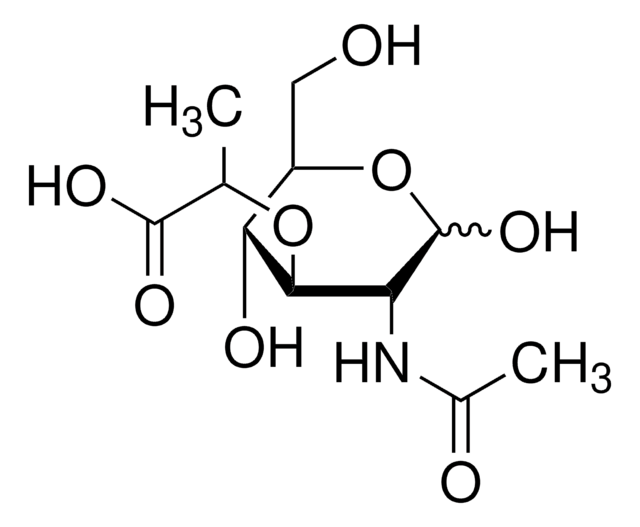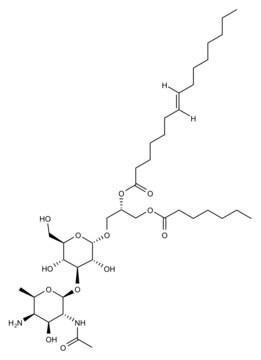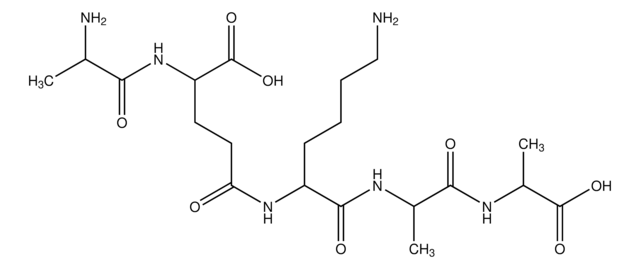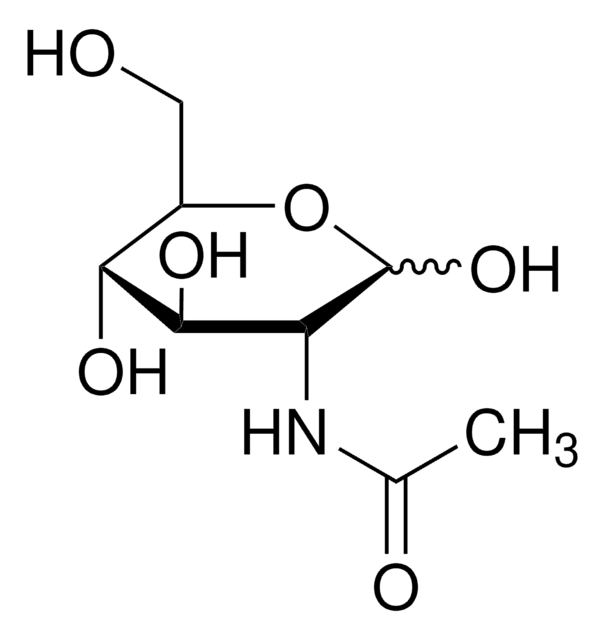69554
Peptidoglycan from Bacillus subtilis
Synonym(s):
PGN
Sign Into View Organizational & Contract Pricing
All Photos(1)
About This Item
Recommended Products
Looking for similar products? Visit Product Comparison Guide
Related Categories
General description
Peptidoglycan.is a biopolymer that is a major component of the cell walls of Gram-positive bacteria. Peptidoglycan consists of a carbohydrate backbone of alternating units of N-acetyl glucosamine and N-acetyl muramic acid and is modified with both D- and L-amino acids. N-Acetyl muramic acid residues are cross-linked with oligopeptides. The terminal peptide is D-alanine although other amino acids are present as D-isomers.
Application
Peptidoglycan may be used for the activity estimation of lytic enzymes (e.g. lyticase). It is recommended to use a peptidoglycan concentration of 0.15-3 μg/ml in water or buffer and measuring at 450 nm. The peptidoglycan is not soluble but produces a suspension in water.
Peptidoglycan activates the Toll-like receptor 2 (TLR2), present in mammalian cells for the stimulation of lymphocytes. It may also function as an antagonist of Poly (I:C).
Peptidoglycan activates the Toll-like receptor 2 (TLR2), present in mammalian cells for the stimulation of lymphocytes. It may also function as an antagonist of Poly (I:C).
Packaging
Bottomless glass bottle. Contents are inside inserted fused cone.
Storage Class Code
11 - Combustible Solids
WGK
WGK 3
Flash Point(F)
Not applicable
Flash Point(C)
Not applicable
Personal Protective Equipment
dust mask type N95 (US), Eyeshields, Gloves
Choose from one of the most recent versions:
Already Own This Product?
Find documentation for the products that you have recently purchased in the Document Library.
Customers Also Viewed
Angela Cuttitta et al.
Fish & shellfish immunology, 67, 86-94 (2017-06-06)
Gene family encoding allograft inflammatory factor-1 (AIF-1) is well conserved among organisms; however, there is limited knowledge in lower organisms. In this study, the first AIF-1 homologue from cnidarians was identified and characterised in the sea anemone Anemonia viridis. The
Yichao Xie et al.
Fish & shellfish immunology, 106, 384-392 (2020-08-11)
Antimicrobial peptide (AMP) is a crucial component of the innate immune system in crustaceans. In mud crab, Scylla paramamosain, a commercially important species, a glycine-rich antimicrobial peptide (Spgly-AMP) gene was newly identified and putatively encoded a 26aa signal peptide and
Christian Stelter et al.
PloS one, 6(6), e20749-e20749 (2011-06-23)
Intestinal inflammation induces alterations of the gut microbiota and promotes overgrowth of the enteric pathogen Salmonella enterica by largely unknown mechanisms. Here, we identified a host factor involved in this process. Specifically, the C-type lectin RegIIIβ is strongly upregulated during
Qian Zhu et al.
Fish & shellfish immunology, 100, 9-17 (2020-03-05)
Interleukin (IL)-11 is a multifunctional cytokine that exerts a series of important immunomodulatory effects and exists in many tissues and cells. A 1106-bp nucleotide sequence representing the complete cDNA of IL-11 was obtained from large yellow croaker (Larimichthys crocea), containing
Yu-Yuan Chen et al.
PloS one, 9(12), e115232-e115232 (2014-12-18)
Invertebrates rely on an innate immune system to combat invading pathogens. The system is initiated in the presence of cell wall components from microbes like lipopolysaccharide (LPS), β-1,3-glucan (βG) and peptidoglycan (PG), altogether known as pathogen-associated molecular patterns (PAMPs), via
Articles
The basic structure of peptidoglycan (PGN) contains a carbohydrate backbone of alternating units of N-acetylglucosamine (GlcNAc) and Nacetylmuramic acid, with the N-acetylmuramic acid residues cross-linked to peptides.
Our team of scientists has experience in all areas of research including Life Science, Material Science, Chemical Synthesis, Chromatography, Analytical and many others.
Contact Technical Service










